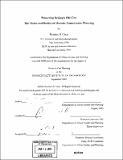| dc.contributor.advisor | Lawrence Vale. | en_US |
| dc.contributor.author | Chen, Beatrice B. (Beatrice Bee Fang), 1976- | en_US |
| dc.contributor.other | Massachusetts Institute of Technology. Dept. of Urban Studies and Planning. | en_US |
| dc.date.accessioned | 2006-03-24T18:13:03Z | |
| dc.date.available | 2006-03-24T18:13:03Z | |
| dc.date.copyright | 2003 | en_US |
| dc.date.issued | 2003 | en_US |
| dc.identifier.uri | http://hdl.handle.net/1721.1/30027 | |
| dc.description | Thesis (M.C.P.)--Massachusetts Institute of Technology, Dept. of Urban Studies and Planning, 2003. | en_US |
| dc.description | Includes bibliographical references (leaves 68-72). | en_US |
| dc.description.abstract | In 2000, the Beijing Municipal Planning Commission drew up a conservation plan for the 25 historic areas in Beijing's Old City. The main principles for the conservation plan were as follows: 1) To preserve the traditional cityscape and hutongs, 2) To ensure the authenticity of the preserved heritage, 3) To implement preservation using a gradual and measured method, 4) To improve the infrastructure and living conditions of the local residents, and 5) To encourage public participation. The residential district of Nanchizi was one of the 25 designated historic areas. In 2001, the area became the pilot site for the implementation of the conservation plan. In June 2002, demolition crews arrived at Nanchizi ready to destroy the courtyard homes. The resulting transformation of Nanchizi reveals that the plan did not succeed in preserving the historic area. This thesis explains why this initial implementation of the historic conservation plan failed to achieve the principles of the plan and examines the causes of this disparity between the vision and the reality of conservation planning in Beijing. It argues that the cause of the disparity between vision and reality lies in the competing visions of those involved in the planning process and that certain visions are valued over others. This cause stems from the inability of planning institutions and processes to respond to the political and economic transitions of China in the past decade. The thesis concludes that in order to succeed in conservation, the function and process of planning must be reconsidered. In addition, the discourse on conservation should also be reexamined in order to ensure that other designated conservation districts of Beijing do not suffer the same fate as the Nanchizi historic area. | en_US |
| dc.description.statementofresponsibility | by Beatrice B. Chen. | en_US |
| dc.format.extent | 73 leaves | en_US |
| dc.format.extent | 3879747 bytes | |
| dc.format.extent | 3879554 bytes | |
| dc.format.mimetype | application/pdf | |
| dc.format.mimetype | application/pdf | |
| dc.language.iso | eng | en_US |
| dc.publisher | Massachusetts Institute of Technology | en_US |
| dc.rights | M.I.T. theses are protected by copyright. They may be viewed from this source for any purpose, but reproduction or distribution in any format is prohibited without written permission. See provided URL for inquiries about permission. | en_US |
| dc.rights.uri | http://dspace.mit.edu/handle/1721.1/7582 | |
| dc.subject | Urban Studies and Planning. | en_US |
| dc.title | Preserving Beijing's Old City : the vision and reality of historic conservation planning | en_US |
| dc.type | Thesis | en_US |
| dc.description.degree | M.C.P. | en_US |
| dc.contributor.department | Massachusetts Institute of Technology. Department of Urban Studies and Planning | |
| dc.identifier.oclc | 55082878 | en_US |

